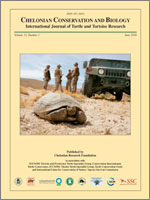Turtles face unique conservation challenges in modern modified river systems. Despite their ecological importance, gaps in knowledge still exist that may hinder their conservation. Turtle by-catch data from the US Army Corps of Engineers' Long-Term Resource Monitoring Program were analyzed for 5 turtle species (false map turtle, Graptemys pseudogeographica; red-eared slider, Trachemys scripta; common snapping turtle, Chelydra serpentina; smooth softshell turtle, Apalone mutica; and spiny softshell turtle, Apalone spinifera) to better understand macrohabitat and mesohabitat use. These species demonstrated differences in habitat use between various macrohabitats, substrata, velocity classes, and depth classes. Common snapping turtles and spiny softshell turtles were captured most often in tributaries, whereas red-eared sliders were captured most often in tributaries and closed side channels. Smooth softshell turtles used open side channels and unstructured main-channel borders most often. False map turtles were found in a variety of macrohabitats, but catch was highest near main-channel wing dikes. Shallow, low-velocity habitat seems most important to turtles. Turtle-specific sampling methods should be employed to learn more about turtles in the middle Mississippi River.
How to translate text using browser tools
1 June 2016
Habitat Use by Five Turtle Species in the Middle Mississippi River
Andrew P. Braun,
Quinton E. Phelps
ACCESS THE FULL ARTICLE

Chelonian Conservation and Biology
Vol. 15 • No. 1
June 2016
Vol. 15 • No. 1
June 2016
Apalone mutica
Apalone spinifera
by-catch
Chelydra serpentina
common snapping turtle
false map turtle
Graptemys pseudogeographica




